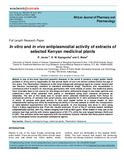| dc.contributor.author | Jeruto, P. | |
| dc.contributor.author | Nyangacha, R. M. | |
| dc.contributor.author | Mutai, C. | |
| dc.date.accessioned | 2024-02-08T14:52:39Z | |
| dc.date.available | 2024-02-08T14:52:39Z | |
| dc.date.issued | 2015-02-14 | |
| dc.identifier.uri | https://academicjournals.org/journal/AJPP/article-full-text-pdf/51D56E953498.pdf | |
| dc.identifier.uri | http://ir-library.mmust.ac.ke:8080/xmlui/handle/123456789/2633 | |
| dc.description.abstract | Malaria is one of the most important parasitic diseases in the world. It remains a major public health
problem in Africa and is responsible for the annual death of over one million children below the age of
five years. The Plasmodium falciparum is the most widespread etiological agent for human malaria and
has become increasingly resistant to standard antimalarial drugs. Therefore, this necessitates a
continuous effort to search for new drugs, particularly with novel modes of action. The medicinal plants
have invariably been a rich source for new drugs and some antimalarial drugs in use today (quinine and
artemisinin) were either obtained from plants or developed using their chemical structures as
templates. The aim of the study was to screen seven selected medicinal plants from Kenya for
antimalarial activity. 21 extracts from seven plants, were selected for in vitro antimalarial screening out
of which 10 extracts with good activity in vitro were tested further in a mouse model. In vitro
antiplasmodial testing was done by measuring the ability of the test sample to inhibit the incorporation
of radio-labelled hypoxanthine into the malaria parasite. In vivo bioassay was done in mice using
Peter’s 4-days suppressive test. From the results achieved, 10 out of the 21 extracts tested, exhibited
antiplasmodial activity, with IC50 values ranging from 6.93 to 88.4 µg/ml. When tested in vivo, one of the
extracts had high activity with chemo suppression of 82.17%, while the rest ranged between 39.93 and
61.86%. The activities observed especially with the methanol extracts indicate that these plants deserve
to be investigated further as potential antimalarial agents. | en_US |
| dc.language.iso | en | en_US |
| dc.publisher | African Journal of Pharmacy and Pharmacology | en_US |
| dc.subject | In vitro , in vivo, antiplasmodial, activity, extracts,selected, Kenyan, medicina,l plants | en_US |
| dc.title | In vitro and in vivo antiplasmodial activity of extracts of selected Kenyan medicinal plants | en_US |
| dc.type | Article | en_US |

